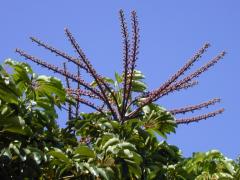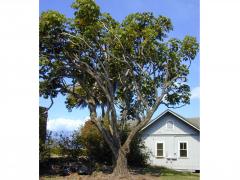Invasive Species: Schefflera actinophylla, Octopus Tree
Octopus tree is invasive and can grow to 40 ft. (12.2 m) tall. Stems can be single or multi-stemmed. Leaves are palm-like with 7 to 16 leaflets. Leaflets are ovate, entire, and 12 in. (30 cm) long. Flowering occurs in summer to early fall, when large red inflorescences develop at the stem tips. Flowers are red and 1 in. (92.5 cm) wide. Fruits are round, dark purple, and 1/4 in. (7 mm) in diameter. Octopus tree is native to Australia and was introduced into Florida in 1927 as an ornamental. Plants can tolerate a wide range of sun and moisture levels but are restricted to areas with minimum temperatures above 35°F (1.7°C).
What are invasive species and why should we be concerned about them?
Taxonomy: Scientific and Common Names for This Species
Apiales > Araliaceae > Schefflera actinophylla (Endl.) H.A.T. Harms
Synonym(s): brassaia, ivy palm, schefflera, umbrella tree
Schefflera actinophylla – USDA PLANTS Profile
Distribution Maps
Octopus tree – The reported distribution of this invasive species across the United States. (Source: Invasive Plant Atlas of the United States)
Up-to-the-minute distribution maps and why they are important.
Reporting This Invasive Species
What is the best way and place to report the occurrence of an invasive species?
How to report an invasive species sighting to EDDMapS – Early Detection & Distribution Mapping System
EDDMapS – Report an invasive species to EDDMapS
Cooperative Extension Offices – Find your local Cooperative Extension office on this map provided by USDA
How to Identify
This invasive species can be identified by looking for the characteristics described in the paragraphs that follow.
Tree
Octopus tree is invasive and can grow to 40 ft. (12.2 m) tall.
|
|
 |
| Forest & Kim Starr, Starr Environmental, bugwood.org | Forest & Kim Starr, Starr Environmental, bugwood.org |
Foliage
Leaves are palm-like with 7 to 16 leaflets. Leaflets are ovate, entire, and 12 in. (30 cm) long.
 |
 |
| Forest & Kim Starr, Starr Environmental, bugwood.org | Forest & Kim Starr, Starr Environmental, bugwood.org |
Flower
Flowering occurs in summer to early fall, when large red inflorescences develop at the stem tips. Flowers are red and 1 in. (92.5 cm) wide.
 |
 |
| Forest & Kim Starr, Starr Environmental, bugwood.org | Forest & Kim Starr, Starr Environmental, bugwood.org |
Fruit
Fruits are round, dark purple, and 1/4 in. (7 mm) in diameter.
 |
|
| Steve Hurst, USDA NRCS PLANTS Database, bugwood.org | bugwood.org |
Native Species That Resemble Octopus Tree
– Images at invasive.org
| bugwood.org | bugwood.org |
– Images at invasive.org
| bugwood.org | bugwood.org |
Additional Images for Octopus Tree
Octopus tree – Images at Invasive.org
Learning Resources for Octopus Tree
Identification and Biology of Non-Native Plants in Florida’s Natural Areas – University of Florida
Additional Information, Biology, Control and Management Resources
Control and management recommendations vary according to individual circumstances. Location, habitat, weather, and a variety of other conditions are factors that help determine the best treatment choice. To find the safest and most effective treatment for your situation, consult your state’s land-grant institution. If you will use chemicals as part of the control process, always refer to the product label.
United States Land-Grant University System – Find your land-grant university’s College of Agriculture, Cooperative Extension Service, or other related partner on this map provided by USDA.
EDIS – IFAS Extension, University of Florida
Schefflera actinophylla – Missouri Botanical Garden
Schefflera actinophylla – Hawaii’s Most Invasive Horticultural Plants
Meet the Plants – National Tropical Botanical Garden
Invasive.org – Center for Invasive Species and Ecosystem Health

